Time to Prepare for Regents and AP Exams
- Details
- Written by Joanne Wallenstein
- Hits: 1665
 (The following is sponsored content from Regents Review)
(The following is sponsored content from Regents Review)
AP and Regents exams are approaching and Regents Review will be again be holding their one-day test prep classes at SUNY Purchase. Learn more about their classes at RegentsReview.com.
About Regents Review
Regents Review is a test prep company that has been preparing students for New York State Regents Exams since 1976. What started out as a basement cram session with a teacher and some students over 40 years ago has now emerged into New York’s leading one-day bootcamp review for not only Regents Exams, but for Advanced Placement Exams and SAT/ACT Exams. The company is family-owned and offers classes in Westchester (Purchase College), Long Island (Adelphi University), and Rockland County (St. Thomas Aquinas College). In addition to in-person offerings, online options are available for many classes.
We review the entire curriculum in one day, and we provide students with study material on the morning of each class. This is great because students do not have to go out and buy any additional books. We then use this material as we go over everything in a topic-by-topic format. Teachers also provide test-taking tricks and techniques. There is a short break every hour, and the students also get a break for lunch. Students often tell us how much more confident they feel at the end of our classes. They frequently continue to review at home using their material.
Every year expert teachers evaluate the material and updates the material as needed. For example, this year, there is a brand new Regents exams in U.S. History. Materials have been updated to reflect these changes, and teachers are well-versed in the new exam format.
Regents Review understands the challenge of exams that cover an entire year’s worth of information. Most students struggle to remember topics that they learned earlier in the year. Instructors alleviate this stress because they teach them everything they need to know for their exams.
We have been in business over 40 years, and we are the original company to offer a one-day test-prep. We do our best to find the most enthusiastic instructors who are passionate about the topic they are teaching. In our experience, students gain so much from our classes that they return to attend multiple subjects.
Customers can register at PassTheRegents.com or RegentsReview.com – or by phone at 877-339-5970.
Expert Warns About Risks to Mental Health and Academic Achievement From Marijuana Use
- Details
- Written by Wendy MacMillan
- Hits: 1512
 Since the legalization of marijuana in New York State you can hardly walk down a street in NYC without being hit with wafts of pot smoke or running into a pop-up dispensary. With its decriminalization, people’s perceptions of cannabis also seems to have changed. Partly aided by clever advertising touting all of the “benefits” of cannabis, a larger population of teens and parents think of it as a relatively safe and benign drug to use. But are these perceptions true?
Since the legalization of marijuana in New York State you can hardly walk down a street in NYC without being hit with wafts of pot smoke or running into a pop-up dispensary. With its decriminalization, people’s perceptions of cannabis also seems to have changed. Partly aided by clever advertising touting all of the “benefits” of cannabis, a larger population of teens and parents think of it as a relatively safe and benign drug to use. But are these perceptions true?
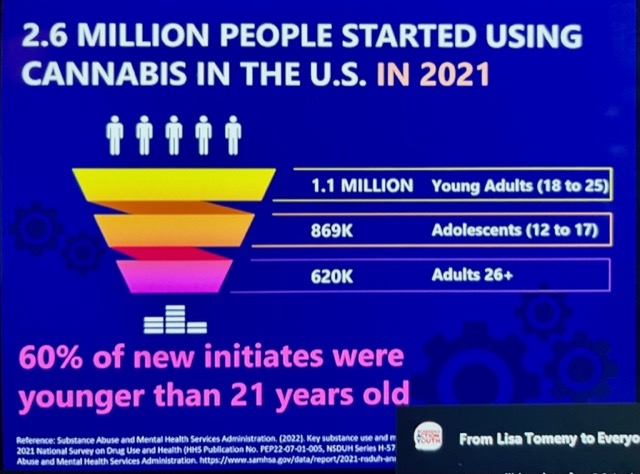 On Tuesday March, 28th Scarsdale Action for Youth (S.A.Y.) hosted a community meeting with Dr. Amelia Arria who informed her audience about the detrimental effects cannabis can have on academic achievement and mental health. Dr. Arria, a Professor and the Director of the Center on Young Adult Health and Development in the Department of Behavioral and Community Health at the University of Maryland School of Public Health, spent ten years with 1,253 students, researching the impact of excessive marijuana use on academic achievement.
On Tuesday March, 28th Scarsdale Action for Youth (S.A.Y.) hosted a community meeting with Dr. Amelia Arria who informed her audience about the detrimental effects cannabis can have on academic achievement and mental health. Dr. Arria, a Professor and the Director of the Center on Young Adult Health and Development in the Department of Behavioral and Community Health at the University of Maryland School of Public Health, spent ten years with 1,253 students, researching the impact of excessive marijuana use on academic achievement.
Dr. Arria began her presentation by highlighting statistics and information. Some significant points included:
-Because of stress related to the pandemic and other influencing factors, teens are experiencing increased levels of mental health issues and say they need our support now more than ever. Parents are the best and most available support for their children.
-In recent years, alcohol use has decreased but cannabis use has increased especially among young adults ages 18-25. Dr. Arria noted a large increase in use among young women.
-Even the cannabis industry believes that people under the age of 21 should not be allowed to use cannabis but our current policies work against this. Cannabis is very easy to access.
-The cannabis that people use today is vastly different from what parents may have experimented with growing up. Today’s cannabis is much more potent and contains way more THC than even 10 years ago. Because of how different cannabis is today, we have no longitudinal studies of the long term effects of modern cannabis use.
-There are many misperceptions in regard to cannabis use including that it is a substitute for drinking alcohol. In fact, oftentimes cannabis and alcohol are being used together.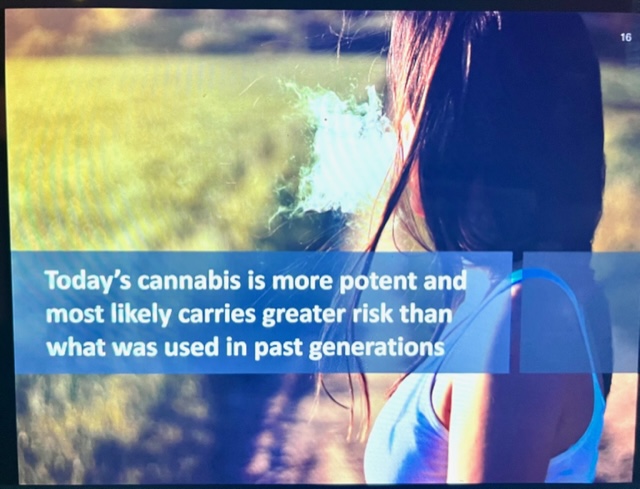
In the next part of her presentation Dr. Arria explored how cannabis use can negatively impact academic achievement. During the discussion, she emphasized that it is not only grades that are affected but also the “human skills” that are needed to succeed both academically and in the job world; skills such as: motivation, verbal and written communication skills, problem solving skills, resourcefulness and so much more. In one slide Dr Arria pointed out that college grads think they are far more prepared with these types of skills than employers do. A few of the other ways cannabis use can impair academic achievement include:
-Neurocognitive tests and other scientific research have proven that cannabis use negatively impacts the developing brain and that the more frequent the use, the greater the deficits.
-Cannabis use impairs cognitive function including perception and focus, selective attention, and learning and information processing…all of which are essential for maximizing academic potential.
-Cannabis use can hijack reward pathways of the brain. The immediate gratification associated with drug use can detract from other priorities like fulfilling responsibilities. A student’s focus on academic pursuits becomes blurred as drugs become more valued.
-Cannabis use can cause short term cognitive effects, cloudy thinking, and lack of motivation.
A lack of motivation and the desire to initiate tasks becomes more persistent with more frequent use.
-College students who used marijuana in the last year were twice as likely to skip class.
-There is a strong correlation between chronic use of cannabis and college drop out rates.
-Marijuana use is associated with lower reading and math scores on standardized tests.
-And yes, among the university research group, marijuana use was found to markedly affect a student’s GPA.

In addition to the ways in which cannabis use can affect a student’s academic achievement, Dr. Arria explained that colleges and universities are overwhelmed with mental health issues and how these issues are confounded by an increase in marijana use. While many believe that cannabis can help improve stress and anxiety, Dr. Arria described that actually the opposite is true. Though cannabis use can provide a short term mood change and an escape from uncomfortable feelings, it is an unhealthy coping skill that interferes with the opportunity to work through discomfort and learn effective coping strategies. Because users don’t learn to effectively deal with their problems, in addition to temporarily disengaging from their responsibilities, using cannabis as a coping strategy can actually worsen stress and anxiety and can trigger the onset of more adverse problems. Dr. Arria emphasized that science has proven over and over again that marijuana use can exacerbate existing disorders and is especially dangerous for the developing brain. She also highlighted the significant association of cannabis use with depression, anxiety, bipolar disorder, suicide behaviors, and psychosis and schizophrenia. And while smoking pot a few times in high school might not trigger any of these potential problems, it is important to consider influencing factors such as age of initiation, frequency of use, potency, and genetic or biological risk factors.
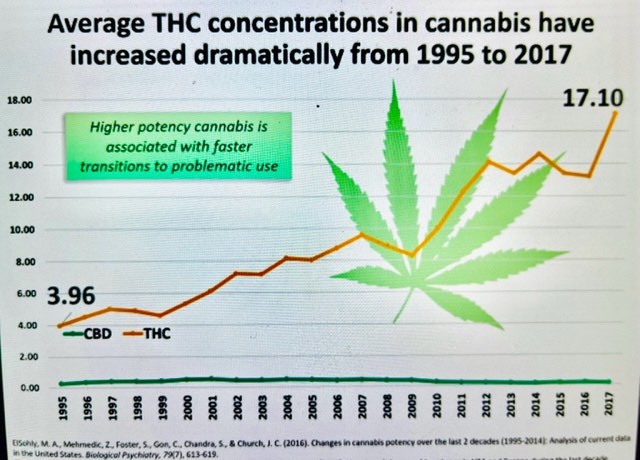 So knowing all of these risks, what are parents and caregivers to do? Dr. Arria suggests that first and foremost, prevention is key…the longer people delay the use of marijuana, the better. While treatment for cannabis use does exist, it is hard to find and isn’t always successful. Some of Dr. Arria’s other suggestions for parents include:
So knowing all of these risks, what are parents and caregivers to do? Dr. Arria suggests that first and foremost, prevention is key…the longer people delay the use of marijuana, the better. While treatment for cannabis use does exist, it is hard to find and isn’t always successful. Some of Dr. Arria’s other suggestions for parents include:
-Learn to detect individuals at risk for substance abuse such as: re-prioritization of activities, spending time partying at the expense of school obligations, trouble sleeping without cannabis or alcohol, difficulty socializing without cannabis, not being able to take a break from using, and using substances to cope with stress.
-Maintain constructive communication. Have conversations about OPPORTUNITIES to use substances and peer use.
-Help your children visualize their futures.
-Maintain vigilance and facilitate help-seeking
-Know the safety nets offered at schools and in the community (In Scarsdale we are fortunate to have RESET which is a free program of prevention education and early intervention designed for Scarsdale youth ages 13-16 who have become “substance involved” with nicotine, alcohol, and/or THC. For more information For more information, call 914-723-3281 or email info@sfcsinc.org.
-Counter misperceptions. The cannabis industry has done a great job of advertising products as safe and beneficial for your health…make sure kids know the facts and how to find information from reliable sources.
-Help improve your child’s health literacy. Make sure your children have the ability to find and understand health information and services, and how to make well-informed decisions about their health.
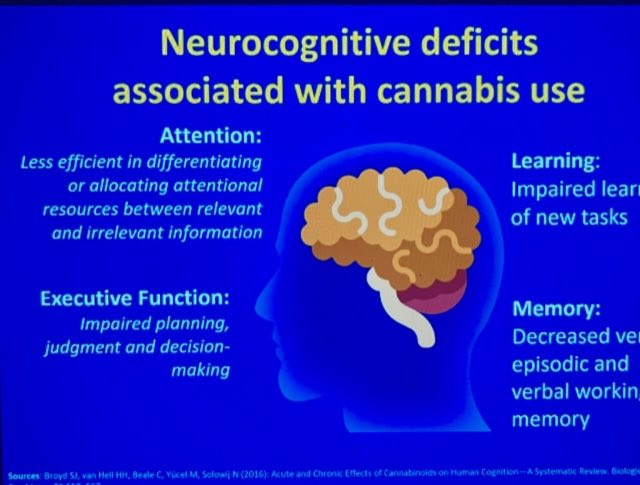
Dr. Arria suggested that one of the best ways to protect children is to set limits and boundaries for them, adding that how parents talk to their child about alcohol and cannabis use, really matters. Data from the Maryland Collaborative 2020 survey found college students who believed their parents disapproved of cannabis use were less likely to use marijuana. It also found that parents who only provided harm-reduction messages (i.e. how to be safe while drinking and that some alcohol is acceptable) were at the highest risk of drinking excessively in college.

For more helpful information about this topic and so much more, please see the Scarsdale Advocates for Youth website. To learn more about Dr. Arria and her work, please click here:
Parent to Parent: Carving Out Family Time
- Details
- Written by Joanne Wallenstein
- Hits: 1005
 They say it takes a village to raise a child and we can all use some neighborly or expert advice from time to time. If you find yourself in a parenting pickle and are looking for some friendly suggestions, please submit your questions here. You can submit your queries anonymously and our panel of parents (with backgrounds in education and psychology) will try our best to offer a helpful perspective. No question is too big or too small and if we can’t help, we will find someone who can!
They say it takes a village to raise a child and we can all use some neighborly or expert advice from time to time. If you find yourself in a parenting pickle and are looking for some friendly suggestions, please submit your questions here. You can submit your queries anonymously and our panel of parents (with backgrounds in education and psychology) will try our best to offer a helpful perspective. No question is too big or too small and if we can’t help, we will find someone who can!
Question:
When the kids' activities and adult work schedules aren't conducive to family dinner, what would be a suitable alternative that would achieve similar outcomes?
Answer:
It sure does seem that we are all a bit busier than folks used to be. And although most of our busyness is the result of necessary or enriching activities…it still doesn’t allow for a traditional family dinner with all members gathered around a table every night. Rest assured, there are still plenty of ways to create space to connect as a family.
-First, try finding a time at least one day a week when the entire family can try to commit to a meal together. Sure you still might have someone missing from the table but when the time is carved out and put on the weekly calendar (just like other activities), it encourages everyone to make an effort to be there. And considering everyone’s schedules, that meal might not be a dinner at 6pm…instead, it might be a weekly brunch or lunch.
-In my house, everyone seems to be running around in the morning, rushing to get ready to leave for school or work. But with some families, a “family breakfast” might be the optimal way to connect on a regular basis. It is also a lovely way to start your day on a positive note.
-Have a nightly “family” dinner with whoever can make it that evening. Establish a dinner routine where the children help with creating and cooking healthy menus. Sit at a dining table to eat your meals with any family member who is available to join (and don’t forget to keep your phones and devices off and away so everyone can be present for the precious time together).
-Perhaps try having “dessert time” together even if it is just some cut up fruit or a cup of herbal tea.
-Find other ways to connect in a routine way…maybe try a Sunday hike, game or puzzle night, or walking the dogs together. Try asking your kiddos what they’d like to do and get creative!
And even if we struggle to bring everyone together at the same time, our children will recognize our efforts and it will hopefully convey the importance we place on this time together. Readers, do you have other suggestions? Please leave them in the comments!
Parenting in the age of ever-changing technology is no easy feat, but rest assured you are not alone! Continue to express your thoughts and concerns with other parents and hopefully we can create a community that approaches social media use in a thoughtful and mindful way.
Do you have parenting questions? Submit them here!
Wendy MacMillan is a former teacher and a proud mom of two children. While her background is in psychology and education, Wendy was recently trained in mindfulness at Mindfulschools.org. She has long been passionate about wellness, and as an active member of the Scarsdale PTA, Wendy helped to bring mindfulness to her children's elementary school.
Community Read: No Visible Bruises
- Details
- Written by Joanne Wallenstein
- Hits: 841
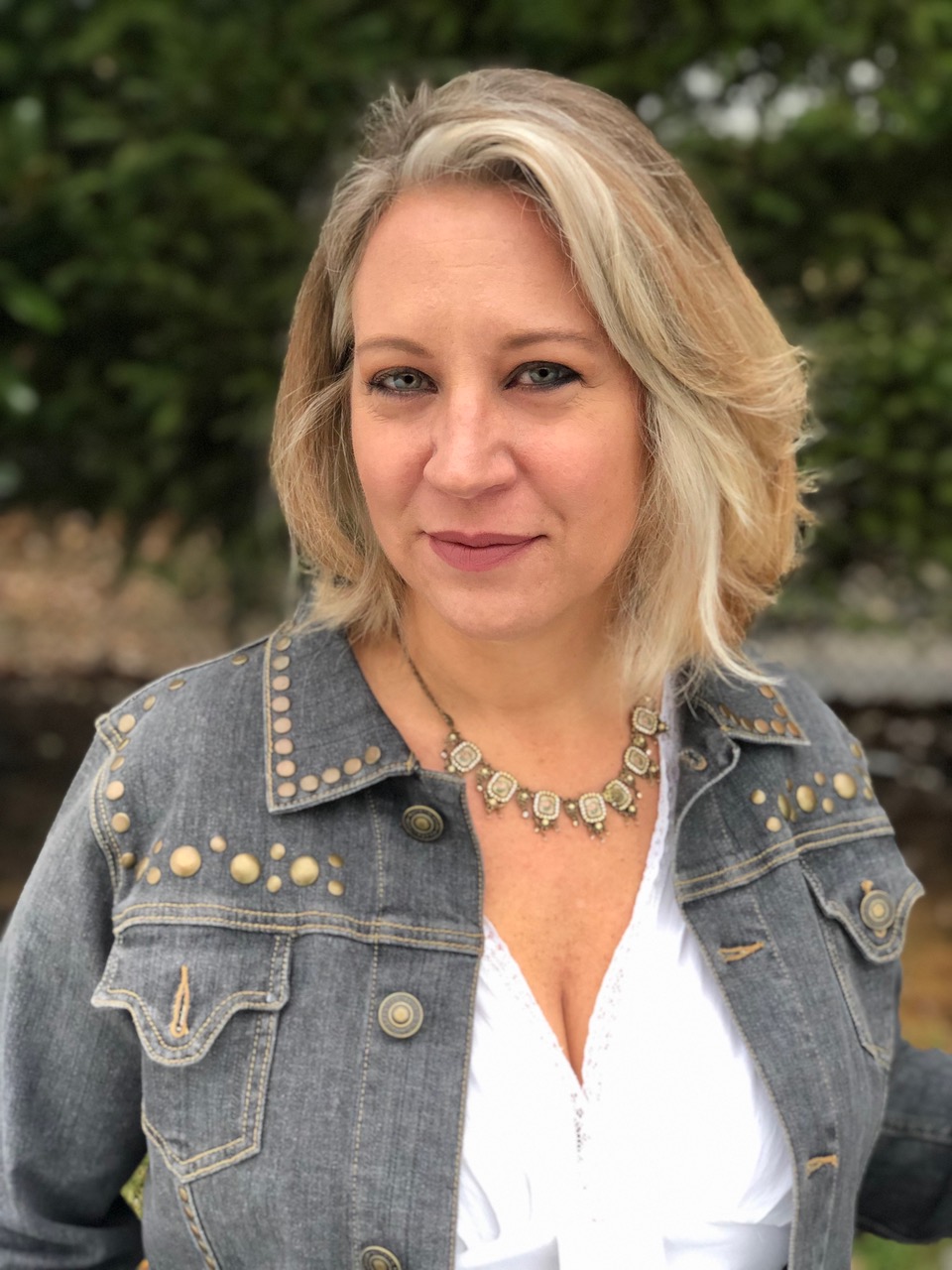 The Scarsdale Public Library and the Scarsdale Edgemont Family Counseling Service's Safe Coalition encourage you to participate in a community book read about the origins and course of gender violence in our society. We invite you to join us for a virtual evening of conversation with Rachel Louise Snyder, author of No Visible Bruises on Tuesday April 18 at 7 pm.
The Scarsdale Public Library and the Scarsdale Edgemont Family Counseling Service's Safe Coalition encourage you to participate in a community book read about the origins and course of gender violence in our society. We invite you to join us for a virtual evening of conversation with Rachel Louise Snyder, author of No Visible Bruises on Tuesday April 18 at 7 pm.
A compelling work of investigative journalism, No Visible Bruises, reveals that one of America’s most urgent social problems takes place behind closed doors, and that the most dangerous place for a woman, statistically, is her own home. Whether we call it domestic violence, private violence, or intimate terrorism, it has a far more pervasive impact on our society than many realize. Between 2000 and 2006, about 3,200 Americans were killed in combat. In that time, more than three times as many women were killed by their partners.
Intimate partner violence is not a private problem. Everyone has a stake in violence prevention.
View the program at home via Zoom. Registrants will be emailed the invitation link approximately one hour before the program starts. Please register here:
Copies of the book are available to borrow from the Scarsdale Public Library, and the book is available to purchase with a 10% discount at the Bronx River Bookstore in Scarsdale Village.
This program is sponsored by The Scarsdale Public Library, the Friends of the Scarsdale Library, Scarsdale Edgemont Family Counseling Service, and Hitchcock Presbyterian Church.
Parenting: Saying No to Social Media Apps When Friends Are On
- Details
- Written by Wendy MacMillan
- Hits: 1865
 They say it takes a village to raise a child and we can all use some neighborly or expert advice from time to time. If you find yourself in a parenting pickle and are looking for some friendly suggestions, please submit your questions here. You can submit your queries anonymously and our panel of parents (with backgrounds in education and psychology) will try our best to offer a helpful perspective. No question is too big or too small and if we can’t help, we will find someone who can!
They say it takes a village to raise a child and we can all use some neighborly or expert advice from time to time. If you find yourself in a parenting pickle and are looking for some friendly suggestions, please submit your questions here. You can submit your queries anonymously and our panel of parents (with backgrounds in education and psychology) will try our best to offer a helpful perspective. No question is too big or too small and if we can’t help, we will find someone who can!
Q: How do we say no to social media apps when all the friends are on it? Should we?
A: While we all know that, when used appropriately and constructively, social media platforms can promote a lot of positivity including connection, awareness, and creativity, the pitfalls of these types of apps are also very real and you are right to be concerned. More and more research points to social media use as a leading factor in the declining mental health of our children, adolescents, and young adults. Because of all the latest data, US Surgeon General Vivek Murthy recently proclaimed on CNN Newsroom that 13 is too young of an age to be on social media. What’s more, in January of this year the Seattle Public School District filed a complaint against social media companies for “creating a mental health crisis” claiming that the “mental health crisis impacts the SPS mission to educate students by draining resources from schools”. If that weren’t enough, a recent study published by JAMA Pediatrics, indicates that habitual checking of social media in early adolescence may be changing the development of preteen brains.
So, armed with all of this information, what are parents to do? To some extent, parenting around social media use can be a personal and familial decision. But since we know that it is nearly impossible for young children to regulate themselves, children and teens need guidance and support from adults to learn how to use social media in a healthy, mindful way. Here are just a few suggestions:
-As a parent, educate yourself about social media and all of the effects it can have on mental health and how the brain develops. The following sites might be helpful:
https://www.humanetech.com/
https://caringforkids.cps.ca/handouts/behavior-and-development/social_media
-Educate yourself about all the various social media apps and the pros and cons of each platform. Here is a good place to start:
-Share what you learn with your children…explain your concerns in an age appropriate manner and try to create a space for them to ask questions and offer their own perspectives. While sticking to our values as parents is important, just as important is making sure our children feel their thoughts are heard and valued as well.
-If your child is old enough, consider watching The Social Dilemma and discussing what you learn.
-Try to delay social media use as long as possible. Several years ago, a group of concerned parents came together to create the Wait Until 8th Pledge. Dr. Murthy also encourages parents to connect with other parents and present a united front, “If parents can band together and say you know, as a group, we’re not going to allow our kids to use social media until 16 or 17 or 18 or whatever age they choose, that’s a much more effective strategy in making sure your kids don’t get exposed to harm early.”
-When you decide your child is at a maturity level to better navigate the pitfalls of social media, introduce only one app at a time and explore the app together. Set clear guidelines and rules that feel right for you and your family. Consider rules like having the passwords to all of your child’s apps in addition to “following” them on all platforms.
https://childmind.org/article/media-guidelines-for-kids-of-all-ages/
https://pcit.ucdavis.edu/wp-content/uploads/2018/07/Teen-Guidelines-logo-1-2.pdf
Parenting in the age of ever-changing technology is no easy feat, but rest assured you are not alone! Continue to express your thoughts and concerns with other parents and hopefully we can create a community that approaches social media use in a thoughtful and mindful way.
Do you have parenting questions? Submit them here!
Wendy MacMillan is a former teacher and a proud mom of two children. While her background is in psychology and education, Wendy was recently trained in mindfulness at Mindfulschools.org. She has long been passionate about wellness, and as an active member of the Scarsdale PTA, Wendy helped to bring mindfulness to her children's elementary school.














